AS Monaco sit in 6th place this season, with the goal of securing UEFA Champions League football after another season in the Europa League. Monaco’s fixtures this season have been quite entertaining, featuring 50 goals in 15 games in the league.
Les Rouge et Blanc have only had 69 corners this season, which is the 11th most out of all teams in Ligue 1 this season, but have scored more from these scenarios than any other club in the league. Philippe Clement has done well to make Monaco so efficient from these scenarios and will look to set pieces to push them up the table in the quest for Champions League football.
In this tactical analysis, we will delve into the tactics Philippe Clement has used to make AS Monaco so dangerous from corners and free kicks. The set-piece analysis will show the different ways that Monaco have been able to win so many headers from a limited number of opportunities. Furthermore, the analysis will look into the movement and routines used, and why this may be the difference between European football and not.
Monaco’s corner opportunities
During offensive corners, Monaco’s set-up could be called cautious. They use 5 players in the box, with one on the edge and one available for the short pass. This leaves Monaco with two players deep in their half, who are irrelevant in such situations, making it easier for teams to defend against, as they have fewer attacking options to deal with. However, while Monaco’s slightly negative corner philosophy could be braver, they have still managed to achieve a lot of success with such methods.
A key part of Monaco’s corner success is their smart use of screens to create openings in dangerous parts of the penalty box. With a smaller number of attacking options, it’s crucial to create space, as it is easier to defend individuals by doubling up on them when man-marking. Monaco use a 2-man screen, on the edge of the 6-yard box, to create space on the edge of the 6-yard box.
Having the 2 blockers means that the zonal markers cannot step forward to attack a cross and so are stuck inside their own 6-yard area. These 2 blockers also prevent the goalkeeper from coming out to claim the cross. This example below shows the 2 Monaco players standing in close proximity to each other setting up a ‘wall’ where the Toulouse defenders cannot step past it. As a result, the area in front of the 6-yard box is open and accessible for players to attack.
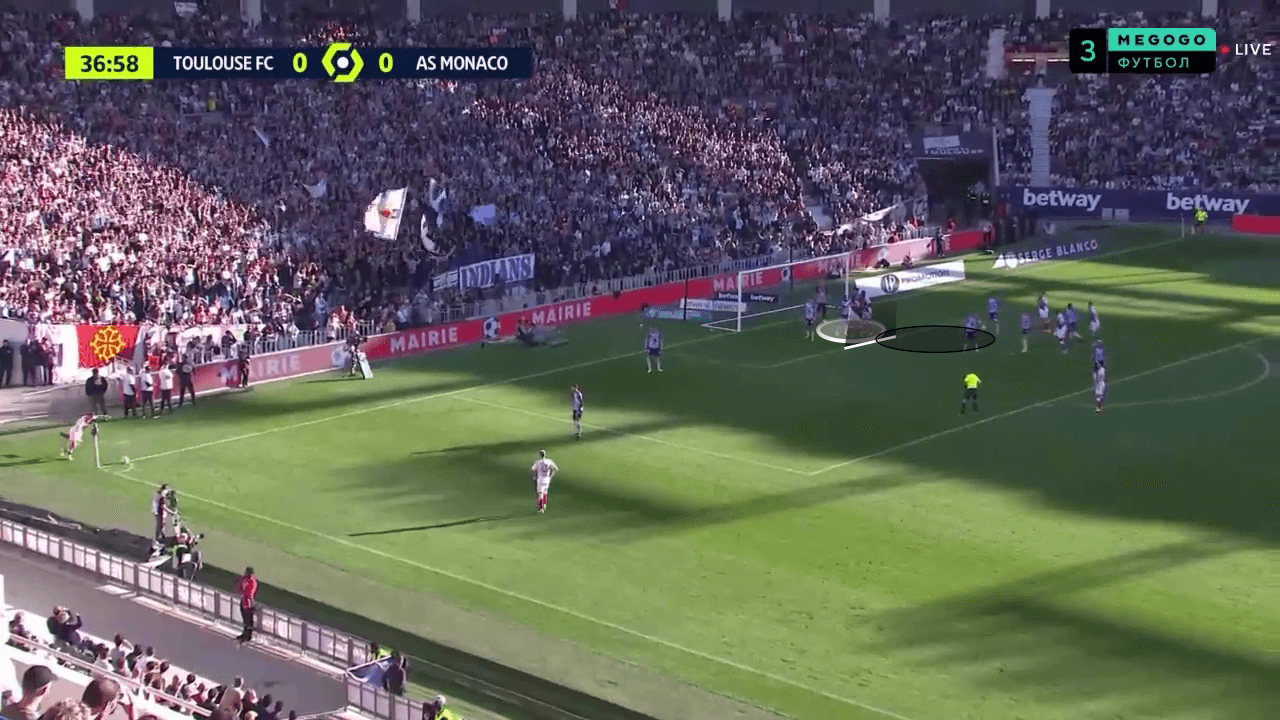
The zone just outside the 6-yard box is usually left open, due to the screening of the 2 Monaco players. In the example below, the 2 screeners move apart from each other to block the zonal markers. This shows the adaptability of the Monaco players to react to situations, and position themselves accordingly to block the players. As a result, we can see Badiashile be allowed to attack the open space, from which he scores a goal.
Some teams attempt to create opportunities closer to goal, but an open header from 8-10 yards away still leads to a very good scoring opportunity, combined with the heading ability in Monaco’s squad means that these lead to chances with a very high likelihood of resulting in a goal.
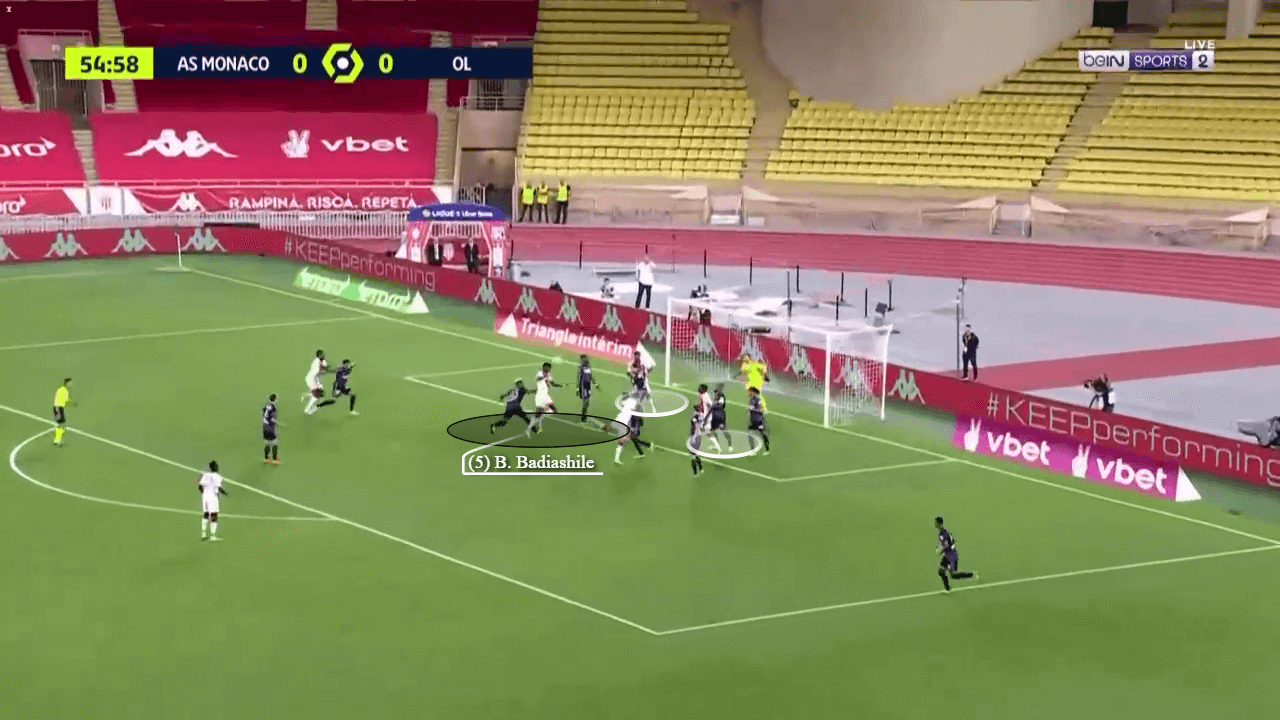
Benoit Badiashile, the man who appears close to a move to Chelsea, is a great example of how Monaco have been so efficient from set-piece situations. Monaco haven’t had many opportunities, but have been efficient from them, as has Badiashile. Due to a low number of corners, 4.6 per game on average, such situations are rare instances for the Monaco players.
The lack of opportunities and not-so-perfect corner deliveries have meant that Badiashile has only gotten his head to 3 corner kicks, but the selfless screening has meant that each opportunity has led to a good goalscoring chance. From this map below, we can see that Badiashile has scored from 2 of 3 headed attempts inside the box because the chances created have been made relatively easy, as well as Badiashile’s excellent heading ability allowing him to be very efficient with his headers.
There is no doubt that Badiashile’s goal tally could rocket up, should Monaco become more dominant in games, which would earn them more corners as well as more consistent corner takers who can find the target area more consistently.
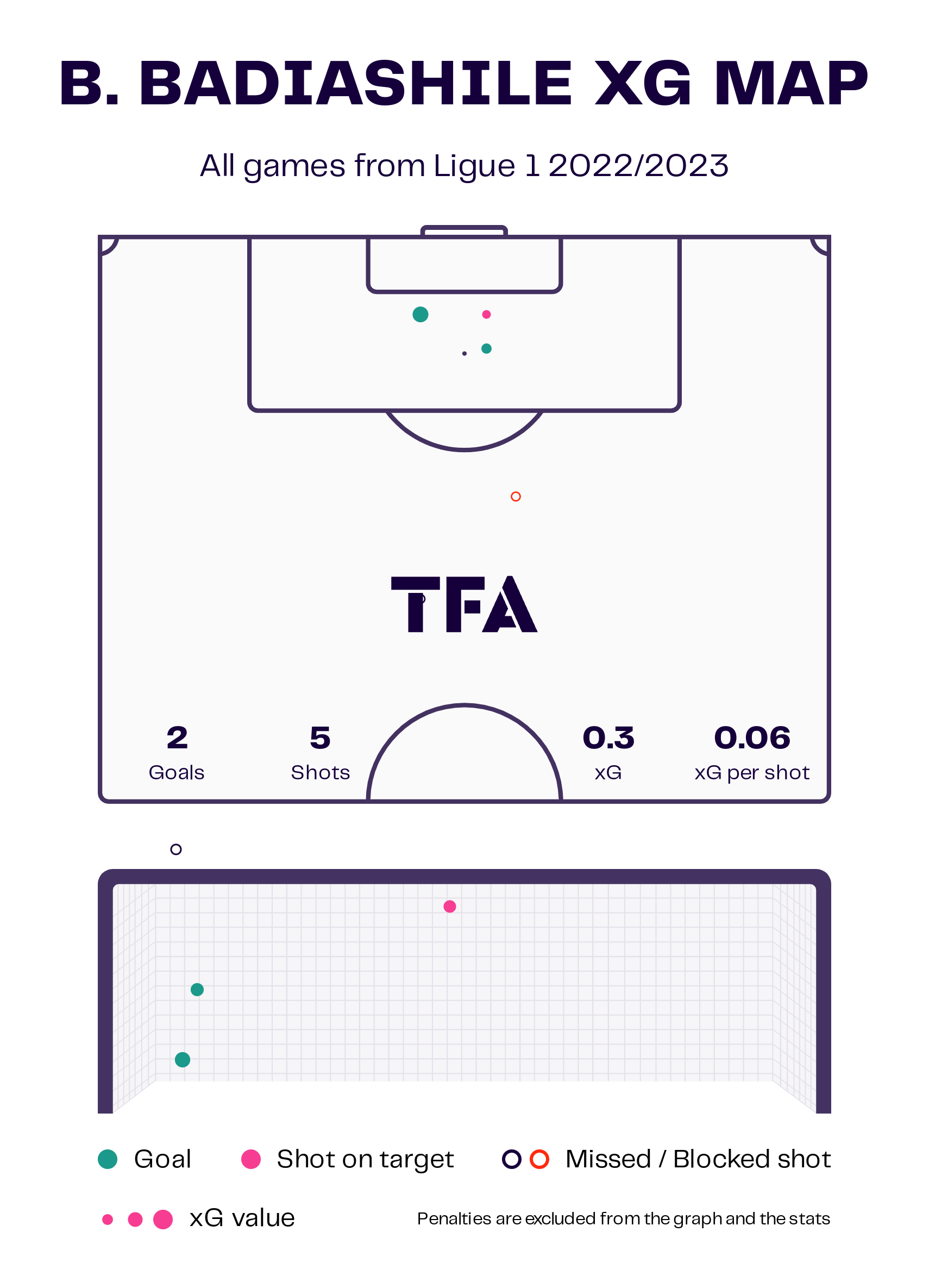
Another way in which Monaco have been creative from corners is by finding the free man on the edge of the box to have a volleyed attempt on goal. Kerpin Diatta has been the man who is the only target for such routines. His ability to track the flight of the ball and connect with the right technique has led to a number of close chances nearly resulting in a goal, with one attempt finding the back of the net. In these scenarios, a ball is lofted towards the edge of the area, whilst Monaco utilise a block again to prevent defenders from intercepting the cross.
This example below shows how crucial these blocks are as they provide Diatta with the time to properly focus on the ball, rather than being worried about a defender potentially clearing the ball out of play.
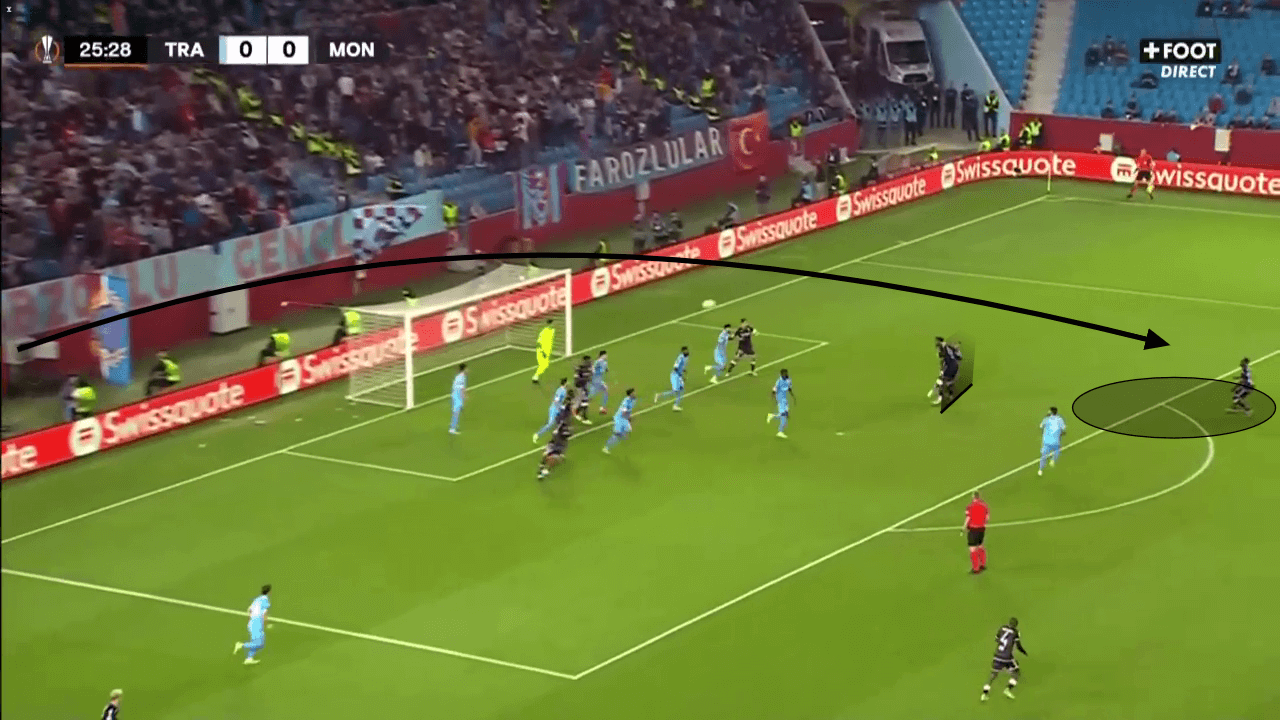
One final way that Monaco utilise these screens, is to create space at the back post. A screen is only possible when a player is close enough to an opponent, to prevent the defender from moving around them. This means that the Monaco player responsible for the screen must be very aware to recognise where the delivery is going so that they can form the appropriate screen to open up a specific area. Once they recognise the target area, the Monaco player, Badiashile in this case, has to quickly react to get tight to the defender responsible for defending the target area so that they can set up a screen where the player becomes immobilised and cannot defend the target area.
Monaco have utilised this to screen either man markers, or zonal markers of the back post, to create lots of space at the back post. Many teams focus on the front post, where it is easier to score from, and as a result, the back of the 6-yard box is usually left undermarked where not enough defenders position themselves to appropriately defend that area. The example below shows this happening in a game where the zonal marker at the 6-yard box is screened which leaves Disasi to attack a header unopposed from around 10-12 yards.
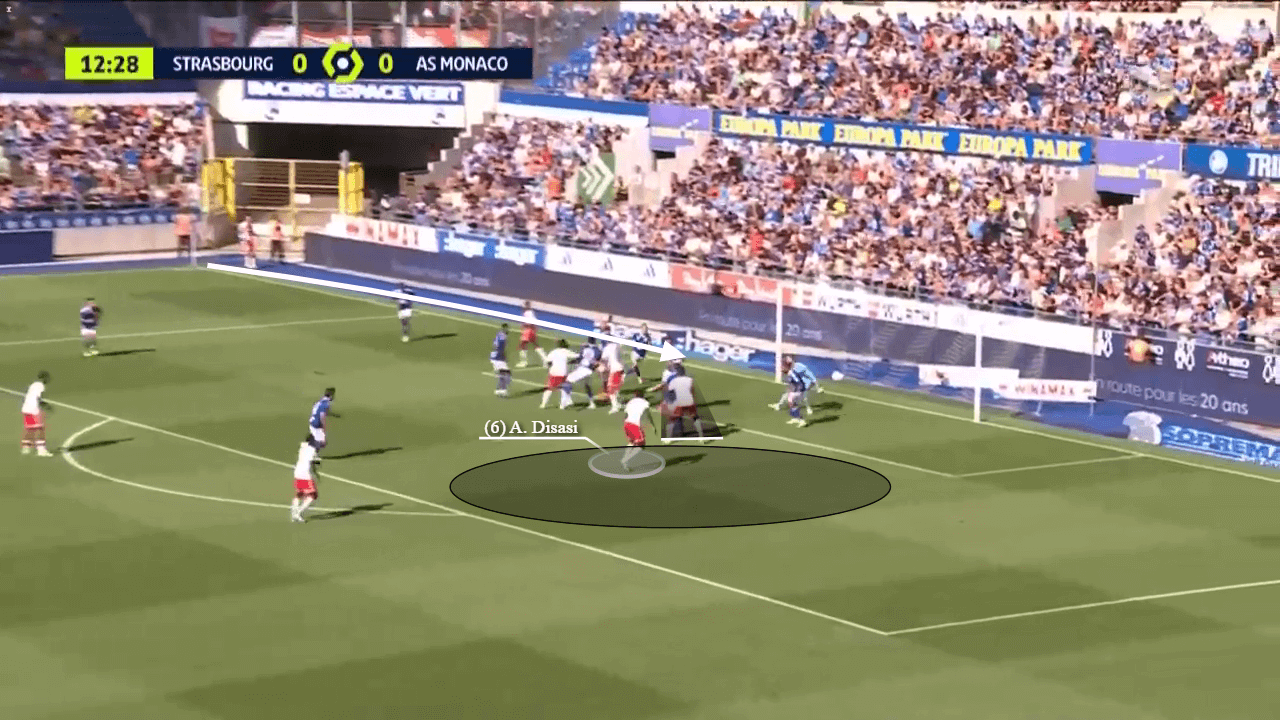
As seen in the image above, Monaco often attempt to provide a free header for the man at the back of the 6-yard box, where it is usually easier to get the first contact on a cross. In some situations, the block isn’t formed due to a lack of concentration from the other Monaco players where a defender is allowed to battle for the aerial duel. In those situations, the header becomes opposed, making it harder to direct a header towards goal.
When the likelihood of a header going reduces so much, because of an opposed aerial duel, Monaco instead attempt to knock the ball down to attempt to score from the second ball. The individual aerial quality of the likes of Fofana, Disasi, Badiashile, Embolo and Maripan, means that they are often likely to make the first contact on lofted crosses. This means they can regularly get to the cross, and attempt to direct the ball into the path of a teammate who will have an opportunity to volley the ball from 6 yards out.
This method of chance creation can be less effective, due to the knockdowns being harder to accurately play into the path of a teammate. From these crosses, players usually end up being bunched together inside the 6-yard box, where it is nearly impossible for a Monaco player to find space inside. This means it is easier for opponents to clear the second ball, but when it finds a Monaco player, a shot from 6 yards out results in a very high xG chance, like the one below with a value of 0.54 xG.
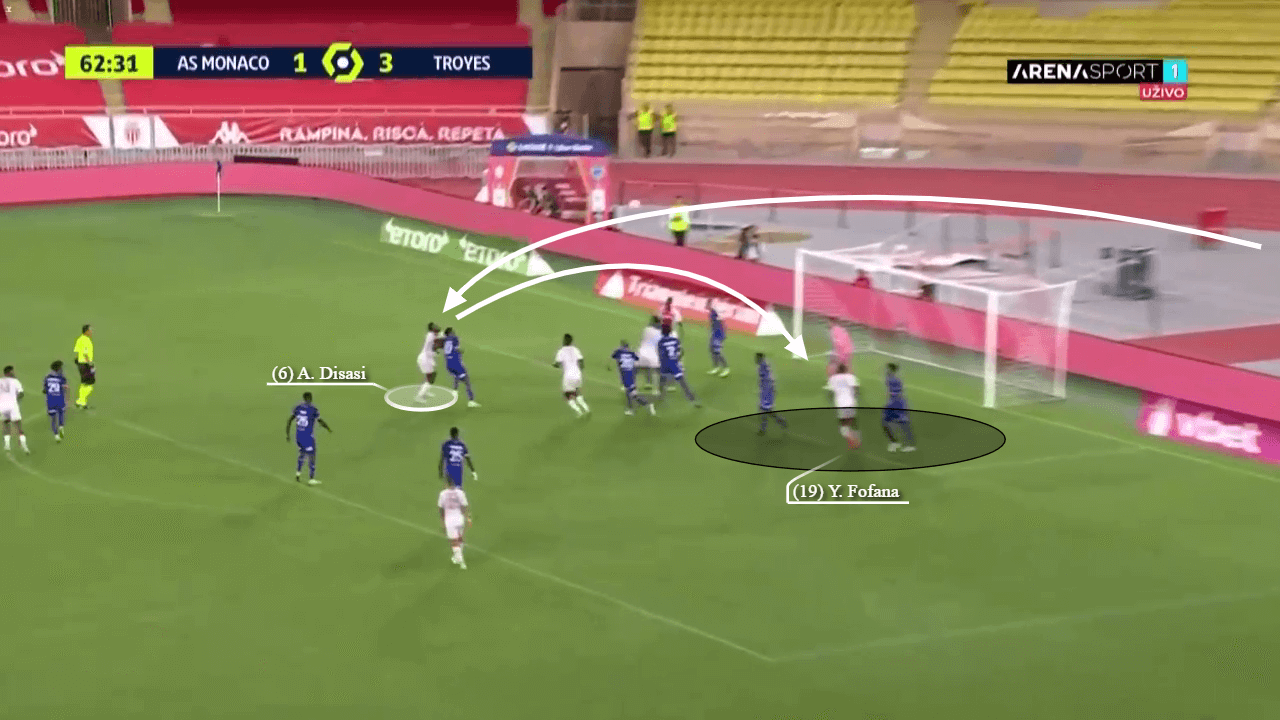
Free kick threat
Monaco have also shown a number of effective ways they have created chances from deep free kicks. A problem Monaco have is that their set piece takers can’t consistently deliver crosses into the target area, so many chances are wasted instantly. However, once the delivery is right, it often leads to good goalscoring opportunities.
The first key factor in Monaco’s free-kick creativity is their use of decoy runs from the takers in order to manipulate the defensive line. In the example below, Henrique pretends to take the free kick before stopping at the last minute, which causes some defenders to step back to defend the space behind them. Golovin then pretends to take the free kick as well. The lack of discipline in the Lyon back line, causes it to become very unorganised. Some players stick to the plan of maintaining a high line, whilst others try to get back early because they fear gifting space for Monaco’s players, and want the head start to get there before Monaco can.
As a result, we can see in the image below, how the defensive line has dropped by about 4 yards, whilst also becoming unorganised and filled with gaps.
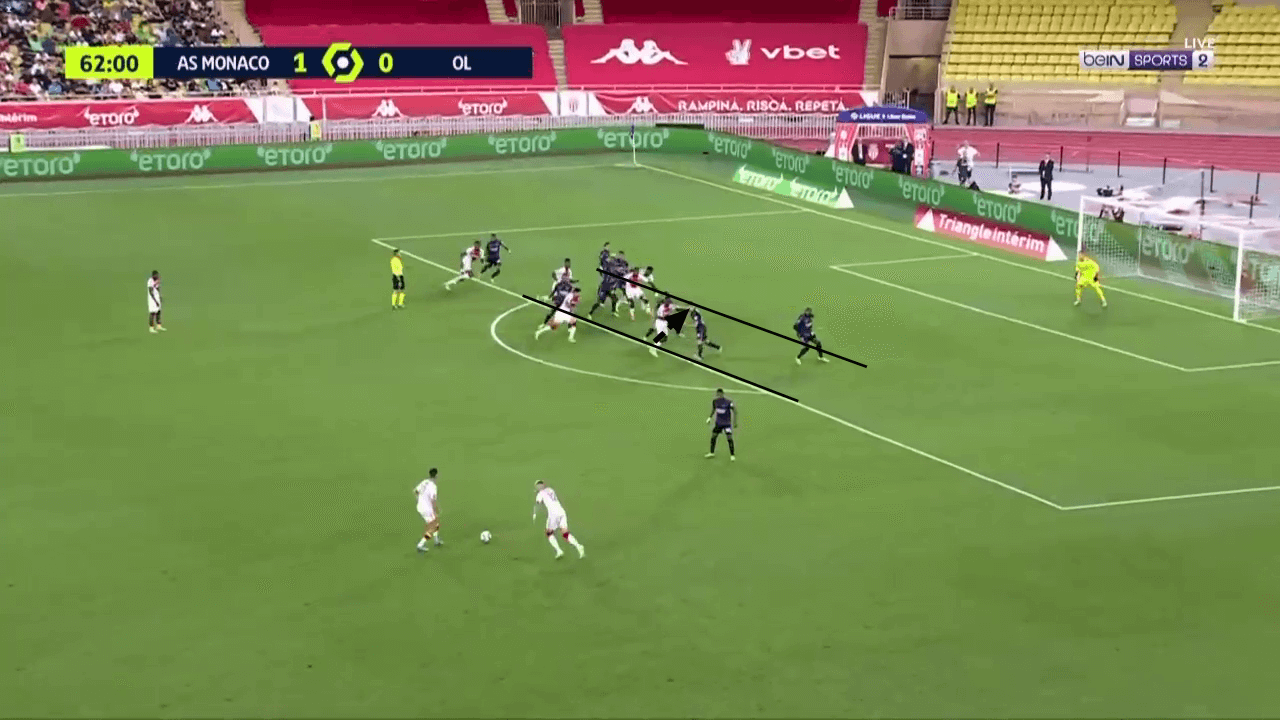
After Monaco make the defensive line so unorganised, the delivery has more room for error, so even a slightly misplaced cross can be successful as the gaps between the players are so large that it becomes easier to find those gaps. From such situations, it is easier for Monaco players to attack the ball as well as they can attack a path unopposed since their supposed markers have already dropped deeper.
An unopposed run makes it easier for the Monaco runners to perfect the angle and timing of their runs so that they can attack a header in an optimal way to have the most power and accuracy on the headed effort. This example below leads to a goal, as the header is attempted from 12 yards away, where Maripan can attack the ball unopposed.
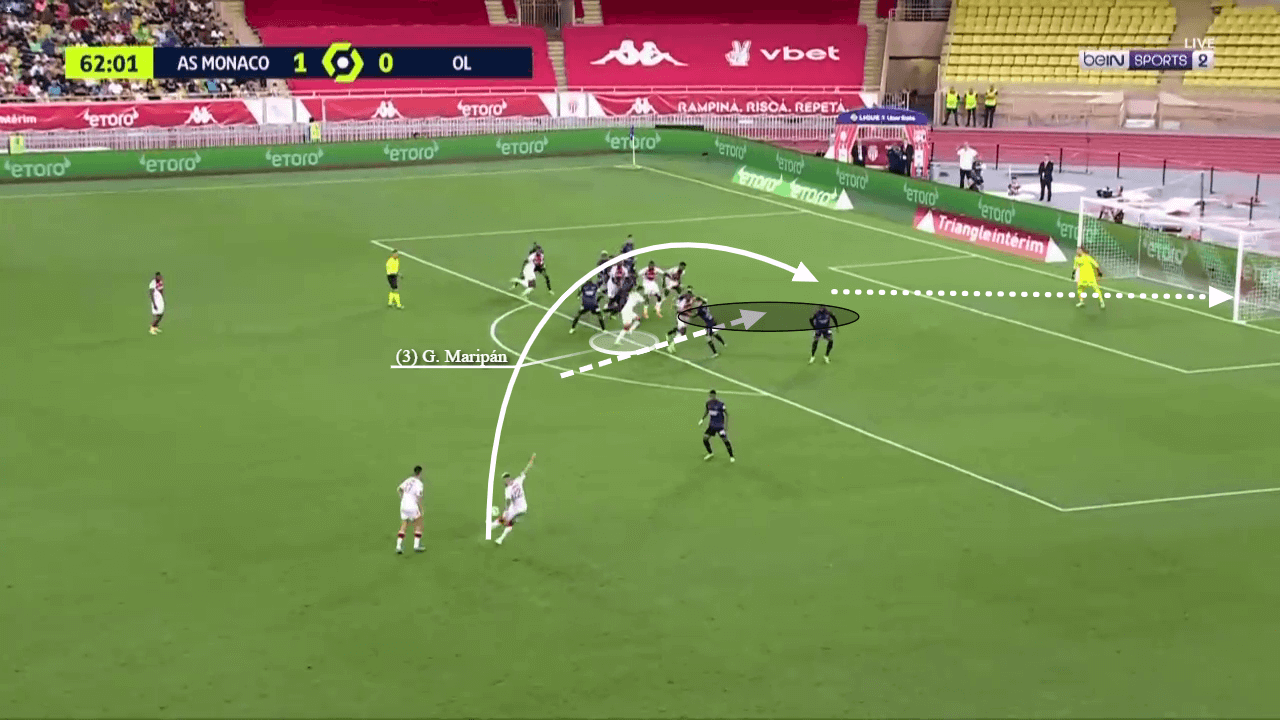
Summary
This set-piece analysis has displayed the different ways in which Monaco have been so efficient from set-piece situations, although the number of corners has been limited in comparison to other sides in the league. The 9% efficiency from corners can be attributed to the pre-planned screens and is impressive considering the fact that a portion of those corners arrive outside the box for speculative volley efforts.
If Monaco were to become braver by increasing the number of players inside the box, the number of goals would further increase, but Philippe Clement prefers to stay cautious and prevent the opposition from scoring on the counterattack.






Comments